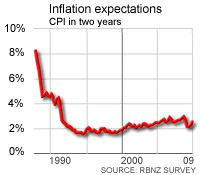Inflation expectations nudge up, but are they anchored?
26th Aug 08, 6:09pm
by
 A Reserve Bank quarterly survey of inflationary expectations by price setters has found the mean expectation for inflation two years out rose to 3.0% from 2.9%, while the median expectation was unchanged at 3%.
The key issue for the Reserve Bank and its critics is whether this is a sign inflationary expectations are anchored with in the 1-3% target band, or whether the Reserve Bank can continue to look through inflation spikes being delivered by higher oil and food prices.
There were 76 people surveyed on August 13 and 14.
Here's the Reserve Bank's commentary on the survey results.
A Reserve Bank quarterly survey of inflationary expectations by price setters has found the mean expectation for inflation two years out rose to 3.0% from 2.9%, while the median expectation was unchanged at 3%.
The key issue for the Reserve Bank and its critics is whether this is a sign inflationary expectations are anchored with in the 1-3% target band, or whether the Reserve Bank can continue to look through inflation spikes being delivered by higher oil and food prices.
There were 76 people surveyed on August 13 and 14.
Here's the Reserve Bank's commentary on the survey results.
Consumer price index (CPI) inflation expectations for both the one and two year horizons have increased since the last survey. Average one-year-ahead Consumers Price Index (CPI) inflation expectations are now 3.6 percent, an increase of 0.3 percentage points since the June quarter survey. Two-year-ahead expectations are now 3.0 percent, compared with a previous figure of 2.9 percent. The median two-year rate is unchanged at 3.0 percent.Expectations of quarterly changes in the CPI for the next two quarters have also increased. Expectations for the September quarter CPI have risen dramatically, from 0.7 percent last quarter to 1.1 percent this quarter. An increase of 0.9 percent is expected for the December 2008 quarter. These quarterly increases are equivalent to annual rates of 4.7 percent for the year to September 2008 and 4.4 percent to December 2008. On average, respondents continue to expect monetary conditions to remain tighter than neutral over the survey period. At the time the survey was completed, the net percentage of respondents who believed monetary conditions were tighter than neutral was 88 percent. This compares with a net 89 percent in the June quarter survey, and a net 83 percent the quarter before. A net 63 percent of respondents believe conditions will be tighter than neutral at the end of December 2008, but for June 2009 this figure falls to 21 percent. Expectations of one and two-year-ahead private sector average hourly earnings are little changed since the June quarter survey. In one year's time earnings are expected to have increased by 3.9 percent (up from 3.8 percent). In two years' time earnings are expected to have increased by a further 3.4 percent. This compares with a two-year expectation of 3.3 percent in the last survey.
The unemployment rate is expected to increase
By March next year the unemployment rate is expected to have increased to 4.1%. A year later the unemployment rate is expected to have increased further, to 4.4%. Both of these expectations are 0.3 percentage points higher than in the March quarter survey. The latest official unemployment figure (for the March 2008 quarter) is 3.6%.Quarterly GDP growth expectations fall
Respondents' one-year-ahead real Gross Domestic Product growth expectations have fallen slightly. For the year to June 2009 respondents expect GDP to increase by 1.3 percent, compared with an increase of 1.4 percent expected in the last survey. Two-year-ahead expectations, however, have increased slightly, to 2.3 percent compared with 2.2 percent previously. The latest Statistics New Zealand data indicates real GDP grew by 1.9 percent between March 2007 and March 2008 (annual percent change). Respondents' expectations of quarterly growth have fallen "“ respondents believe real quarterly growth in GDP will be negative in the next two quarters. Growth in June 2008 was thought to have fallen by 0.2 percent over the June 2008 quarter (compared with an increase of 0.1 percent last survey), and that quarterly growth will be -0.1 percent in the September 2008 quarter. Around 75 percent of respondents believe GDP growth was zero or less than zero in the June 2008 quarter. n exchange rate of US$0.67 is expected for the NZ dollar at the end of December 2008, then falling to US$0.65 by the end of June 2009. Some weakening of the New Zealand dollar against its Australian counterpart is expected "“ respondents believe the NZD/AUD rate will fall to A$0.78 by the end of June 2009.A fall in short term interest rates is expected.
The 90-day Bank Bill rate is expected to be 8.0 percent at the end of September 2008, lower than the rate prevailing at the time of the survey (about 8.2 percent). By June 2009, respondents believe 90-day rates will have fallen to 7.2 percent, suggesting that they believe further OCR reductions will have taken place by that date. 10-year Government Security yields are expected to be around 6.1 percent at the end of June 2009, implying a negative yield gap of -1.1 percent.

We welcome your comments below. If you are not already registered, please register to comment.
Remember we welcome robust, respectful and insightful debate. We don't welcome abusive or defamatory comments and will de-register those repeatedly making such comments. Our current comment policy is here.